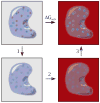Computational methods for biomolecular electrostatics
- PMID: 17964951
- PMCID: PMC2423940
- DOI: 10.1016/S0091-679X(07)84026-X
Computational methods for biomolecular electrostatics
Abstract
An understanding of intermolecular interactions is essential for insight into how cells develop, operate, communicate, and control their activities. Such interactions include several components: contributions from linear, angular, and torsional forces in covalent bonds, van der waals forces, as well as electrostatics. Among the various components of molecular interactions, electrostatics are of special importance because of their long range and their influence on polar or charged molecules, including water, aqueous ions, and amino or nucleic acids, which are some of the primary components of living systems. Electrostatics, therefore, play important roles in determining the structure, motion, and function of a wide range of biological molecules. This chapter presents a brief overview of electrostatic interactions in cellular systems, with a particular focus on how computational tools can be used to investigate these types of interactions.
Figures






References
-
- Alexov E. Role of the protein side-chain fluctuations on the strength of pair-wise electrostatic interactions: comparing experimental with computed pKas. Proteins. 2003;50:94–103. - PubMed
-
- Allison SA, McCammon JA. Dynamics of substrate binding to copper zinc superoxide dismutase. J Phys Chem. 1985;89:1072–1074.
-
- Anderson CF, Record MT., Jr Gibbs–Duhem-based relationships among derivatives expressing the concentration dependences of selected chemical potentials for a multicomponent system. Biophys Chem. 2004;112:165–175. - PubMed
-
- Antosiewicz J, Briggs JM, Elcock AH, Gilson MK, McCammon JA. Computing ionization states of proteins with a detailed charge model. J Comput Chem. 1996a;17:1633–1644.
Publication types
MeSH terms
Substances
Grants and funding
LinkOut - more resources
Full Text Sources

